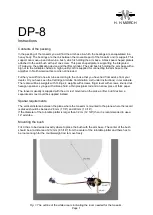
13
Now you can start playing LPs. On a spinning record gently lower the needle into the first
groove. When the needle touches the record it will move in and out a little before settling into
the first groove. If it moves inside, skipping a few grooves or drops from the record, that
means that the horizontality of the tonearm is not correct.
If it jumps out towards the edge of the record, then the tonearm is tilted too much downwards
towards the edge of the LP. You must raise that part of the turntable. If it moves inwards,
towards the centre of the record, then it is tilted too much upwards and you must lower that
part of the turntable. See 5.5.
5.5. Fine horizontal levelling of the tone arm:
Note: Do not use the damping facility while levelling the tone arm! Lift out paddle!
Note: Do not use spirit level for fine levelling adjustment.
This will avoid cartridge skipping in the grooves. The tonearm itself is the best levelling
device.
Bring the cartridge above the LP in the middle of the modulated grooves having the cueing
device in the upper position. Then lift up the headshell and let it drop back towards LP.
The cueing device being in the “up” position will prevent the cartridge dropping on the
LP. The headshell will bounce up and down because rod of cueing device will restrict
movement of the threaded rod of counterweight at the back. At the same time the
whole assembly will drift sideways in one direction, or only move very little.
Try the same experiment above the outer perimeter of the LP and also at the inner grooves
The tone arm is correctly levelled when:
Above the outer grooves the whole assembly moves slowly away from the record.
Above the middle of the grooves it stays more or less stable or has a very small
drift.
Above the inner grooves the whole assembly moves slowly towards the record
centre.
If the tone arm is stable at the outer groove and moves towards the centre at the middle
and inner grooves, then the tone arm should be levelled in such a way, that the whole
assembly will slide towards the outer perimeter of the LP.
If it is stable at the inner groove and moves slowly outwards at the middle and also if at the
outer perimeter of LP it runs outwards (away from LP centre). Then the arm should
be levelled so that the whole assembly will drift towards the LP centre at inner groove.
5.6. Adjustment of VTA:
Note: Do not operate VTA knob while the lever is in the lock position!
VTA is adjusted by rotating the knob on the top of the base. Rotation in the direction of the
arrow (+), means that the tonearm will be raised at the support. A rough scale can be seen on
the front of the main base. This is on a scale of 10mm. In the middle of the scale is a stronger
line indicating the zero starting point. The space between each line represents 1mm
difference. Full rotation of the knob is 8 markings, representing 0.1mm between two lines.





































